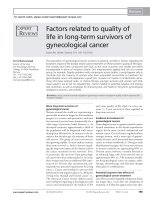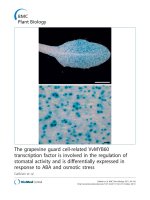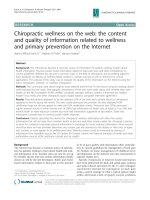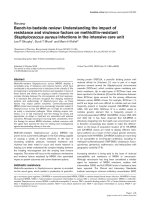Review some factors related to neurological functional recovery outcome in the treatment of acute ischemic stroke by the solitaire device
Bạn đang xem bản rút gọn của tài liệu. Xem và tải ngay bản đầy đủ của tài liệu tại đây (92.62 KB, 6 trang )
Journal of military phrmaco-medicine nO7-2017
REVIEW SOME FACTORS RELATED TO NEUROLOGICAL
FUNCTIONAL RECOVERY OUTCOME IN THE TREATMENT
OF ACUTE ISCHEMIC STROKE BY THE SOLITAIRE DEVICE
Vu Viet Lanh*; Phan Viet Nga**
SUMMARY
Objectives: To review some factors related to neurological functional recovery outcome in
the treatment of acute ischemic stroke by the solitaire device. Subjects and methods: A prospective
study and case series were conducted on 104 patients at People’s Hospital 115 from 4 - 2014 to
9 - 2016. Results: The age group greater than or equal 70 had worse neurological functional
outcome (23.5%) than the group less 70 years old (55.2%), statistically significant difference
(p < 0.03). The good recanalization group had better neurological functional outcomes (59.7%)
than that without good recanalization (22.2%), the difference was statistically significant
(p < 0.05). The group of severe stroke patients (NIHSS > 15) with better neurological functional
outcomes (39.7%) was less than that at the mild and moderate level (NIHSS ≤ 15), statistically
significant difference (p < 0.05). The symptomatic incranial hemorrhage patients with bad
neurological functional outcome (mRS 3 - 6) (100%) were higher than those with asymptomatic
incranial hemorrhage (42.9%), statistically significant difference (p < 0.05). Conclusions: Such
factors as revascularization, severe stroke levels, symptomatic incranial hemorrhage related to
neurological functional recovery outcome.
* Keywords: Acute ischemic stroke; Revascularization; Neurological functional recovery outcome.
INTRODUCTION
Stroke is a common disease in the
world as well as Vietnam. It is the third
most common cause of death after heart
disease and cancer and is the single reason
for permenant disability. More than 700,000
new strokes occur each year in the United
States alone, accounting for more than
45 billion dollars in medical expenses,
rehabilitation costs, and loss of employment
[3].
Stroke is a pathological process. Therein,
the cerebral artery is narrowed or occluded.
The circulating blood volume is severely
reduced, the function of area of the brain
is disordered [1]. A cerebral infarction can
occur for a few minutes as the circulating
blood volume is reduced so it is rapid
revascularization and restoration of
circulation.
In 1996, Food and Drug Administration
(FDA) approved the administration of
intravenous (IV) recombinant tissue
plasminogen activator (rt-PA) within
3 hours of symptoms onset for the treatment
of patients with acute ischemic stroke.
* Thaibinh General Hospital
** 103 Military Hospital
Corresponding author: Phan Viet Nga ()
Date received: 11/07/2017
Date accepted: 08/08/2017
121
Journal of military parmaco-medicine n07-2017
Due to the time limitation and contraindications
to intravenous tissue-type plasminogen
activator (IV tPA), < 10% of patients with
stroke receive the treatment, even in wellorganized stroke networks. Furthermore,
IV tPA recanalizes only 40% of large vessel
occlusions in patients with acute stroke
during the first hours after administration
with even lower rates of revascularization
for proximal arterial occlusions such as
the terminal internal carotid artery. Thus,
faster and more effective approaches to
reperfusion are needed [4]. Clinical results
have shown that mechanical devices for
clot removal provide an alternative treatment
option to patients with stroke who are
ineligible for thrombolytic therapy. The
solitaire device has received US Food
and Drug Administration clearance for use
in the revascularization of patients with acute
ischemic stroke secondary to intracranial
large vessel occlusive disease. In Vietnam,
this approach has been deployed in some
hospitals and received good results.
Therefore, we have studied this topic
to aim: Review some factors related to
neurological functional recovery outcome
in the treatment of acute ischemic stroke
by the solitaire device.
SUBJECTS AND METHODS
1. Subjects.
We conducted a prospective study to
evaluate all consecutive patients with
ischemic stroke, who were treated from
April, 2014 to September, 2016 at
People’s Hospital 115. Patients had
received Solitaire device as the first-choice
122
device to restore blood flow. Patients had a
intracranial and terminus internal carotid
artery (ICA), first and second segments
of the middle cerebral artery (MCA),
basilar artery (BA) and first segment
posterior cerebral artery (PCA), patients
were refractory to intrarvenous IV tPA or
the patient had contraindications for
systemic thrombolysis within 6 hours from
onset stroke symptoms.
* Inclusion criteria:
- No hemorrhage image on CT-scanner
or MRI.
- From the onset of stroke symptoms
to treatment ≤ 6 hours.
- Patients have proximal vessel large
arterial occlusion: Intracranial and terminus
internal carotid artery (ICA), first and
second segments of the middle cerebral
artery (MCA), basilar artery (BA) and first
segment posterior cerebral artery (PCA).
- Patients visit the hospital > 4.5 hours
after the onset of stroke symptoms or
ineligibility for or failure to respond to
intravenous rt-PA.
- Patients and their families agree to
treat.
* Exclusion criteria:
- The exact time of onset stroke symptoms
is unknown.
- Systolic blood pressure ≥ 185 mmHg
or diastolic blood pressure ≥ 110 mmHg is
uncompensated.
- Platelet below 100,000/mm3. Hematocit
below 25%.
- Blood glucose < 50 mg/dL (2.8 mmol/L)
or > 400 mg/dL (22.2 mmol/L).
Journal of military phrmaco-medicine nO7-2017
- Activated partial thromboplastin time
(aPTT) > 50 seconds. Anticoagulation with
IRN (International Normal Ratio) > 3.0 or
administration of heparin within the early
48 hours.
- Ischemic infarction occurs in more than
a third of the middle cerebral artery territory
on CT-scanner.
2. Methods.
Prospective study and case series.
RESULTS AND DISCUSSIONS
1. Age.
Table 1: Age factor related to the neurological functional revovery outcome.
mRS 0 - 2
Age
mRS 3 - 6
Number
(n = 52)
Rate
(%)
Number
(n = 52)
Rate
(%)
< 70
48
55.2
39
44.8
≥ 70
4
23.5
13
76.5
OR
95%CI
p
4.00
(1.2 - 13.2)
0.03
The age group greater than or equal 70 had worse neurological functional outcome (23.5%)
than the group less 70 years old (55.2%), statistically significant difference (p < 0.03).
According to the medical literature, age was a constant risk factor. The higher age it is,
the more the accumulation of risk factors is (vessel disease, atherosclerosis…). In the
studies, the elderly had worse neurological functional revovery outcome than the younger
[6]. However, there is currently no evidence of high levels of (A-level) confidence in the
relationship between age and benefit of the intervention. The main cause may be the
limited number of elderly patients in the intervention studies.
2. Recanalirization.
Table 2: Recanalization related to neurological functional recovery outcome.
mRS 0 - 2
mRS 3 - 6
TICI
Number (n = 52)
Rate (%)
Number (n = 52)
Rate (%)
<2
6
22.2
21
77.8
≥2
46
59.7
31
40.3
OR
95%CI
p
0.19
(0.07 - 0.53)
0.001
The recanalization group had better neurological functional outcome (59.7%) than the
group without good recanalization (22.2%), the defference was statistically significant
(p < 0.05).
According to Joung Ho Rha (2007), there was a relationship between cerebral vascular
reassessment and the level of neurological rehabilitation in patients with acute brain
stroke [7]. Therefore, it was necessary to re-circulate blood vessels early to increase
cerebral circulation and to increase the level of neurological rehabilitation.
123
Journal of military parmaco-medicine n07-2017
3. The severity of stroke according to the NIHSS scale.
Table 3: The severity of stroke according to NIHSS scale related to neurological
function recovery outcome.
NIHSS
mRS 0 - 2
mRS 3 - 6
Number (n = 52)
Rate (%)
Number (n = 52)
Rate (%)
≤ 15
25
69.4
11
30.6
> 15
27
39.7
41
60.3
OR 95% CI
p
3.45
0.007
(1.46 - 8.15)
The number of severity stroke patients (NIHSS > 15) had worse neurological functional
outcome (39.7%) than those at mid and moderate level (NIHSS ≤ 15), statistically
significant deference (p < 0.05).
Currently, there are many scales to review severe stroke levels. Therein, the NIHSS
scale has high specificity and sensitivity, severe stroke levels is directly associated with
high NIHSS score [10]. The NIHSS score scale was capable of predicting neurological
recovery in acute stroke patients. Patients with NIHSS score > 15 are at risk of disability
and poor neurological recovery [5].
4. Symptomatic incranial hemorrhage.
Table 4: Symptomatic incranial hemorrhage related to neurological functional
recovery outcome.
mRS 0 - 2
Symptomatic
incranial hemorrhage
mRS 3 - 6
Number
(n = 52)
Rate
(%)
Number
(n = 52)
Rate
(%)
OR 95% CI
p
No
52
57,1
39
42.9
0.42
> 0.05
Yes
0
0.0
13
100.0
(0.33 - 0.54)
In the study, the symptomatic incranial hemorrhage patients group without good
neurological functional outcome (mRS 3 - 6) (100%) was higher than that with
asymptomatic incranial hemorrhage patients group (42.9%), statistically significant
difference (p < 0.05).
According to Saver and Lanberg (2007), symptomatic incranial hemorrhage was the
most serious complications leading to high mortality and disability after intravenous
thrombolytic and intervention therapy [8, 9].
124
Journal of military phrmaco-medicine nO7-2017
5. Multivariate regression statistical analysis.
Table 5: Multivariate regression statistical analysis of risk factors related to neurological
function recovery outcome.
Factors
< 70
Age
≥ 70
<2
TICI
≥2
Symptomatic incranial
hemorrhage
NIHSS
No
Beta coeficient
p
OR
95%CI
0.121
0.160
4.00
1.2
13.2
- 0.309
0.000
0.19
0.07
0.53
0.319
0.000
0.42
0.33
0.54
0.245
0.005
3.45
1.46
8.15
Yes
≤ 15
> 15
Multivariate regression statistical analysis showed that factors related to neurological
functional recovery outcome include age group, revascularization, symptomatic incranial
hemorrhage, severe stroke leves). Besides, no good revascularization group (TICI 0 - 2A),
symptomatic incranial hemorrhage group, severity stroke group (NIHSS > 15) associated
with impaired neurological functional rehabilitation (mRS 3 - 6).
CONCLUSIONS
- Simple variable statistical analysis:
+ The risk factors related to good
neurological functional outcome: the age
group less than 70, good revascularization
(TICI ≥ 2B), mid and moderate stroke
(NIHSS ≤ 15).
+ The risk factors related to no good
neurological functional outcome: the
age group greater than 70, no good
revascularization (TICI 0 -2A), severity
stroke (NIHSS > 15) and symptomatic
incranial hemorrhage.
- Multivariate regression statistical analysis
revealed that factors related to neurological
functional recovery outcome are age group,
revascularization, symptomatic incranial
hemorrhage, severe stroke levels); no good
revascularization group (TICI 0 - 2A),
symptomatic incranial hemorrhage group,
severity stroke group (NIHSS > 15) associated
with impaired neurological functional
rehabilitation (mRS 3 - 6).
REFERENCES
1. Nguyễn Văn Chương. Thực hành thần
kinh tập III: Bệnh học thần kinh. Nhà xuất bản
Y học. 2005, tr.7-73.
2. Phạm Nguyên Bình. Đánh giá tính an
toàn và hiệu quả phương pháp lấy huyết khối
bằng dụng cụ cơ học solitaire ở bệnh nhân
đột quỵ nhồi máu não. Luận văn Thạc sỹ
Y học. Trường Đại học Y Dược Thành phố
Hồ Chí Minh. 2013.
3. Perry P. Ng, Randall T. Higashida, Sean
P. Cullen et al. Intraarterial thrombolysis trials
125
Journal of military parmaco-medicine n07-2017
in acute ischemic stroke. J Vasc Interv Radiol.
2004, 15, S77-S85.
4. Antoni Davalos, Victor Mendes Peria,
Rene Chapot et al. Retrospective multicenter
study of solitaire FR for revascularization in
the treatment of acute ischemic stroke. Stroke.
2012, 43.
5. Marian Muchada, Marta Rubiera. Baseline
National Institutes of Health Stroke Scale adjusted time window for intravenous tisue type plasminogen activator in acute ischemic
stroke. Stroke. 2014, 45, pp.1059-1063.
6. Messeguer E., Labreuche J., Olive J.M.
et al. Determinants of outcome and safety of
intervenous tr-PA therapy in the older: a
clinical registry study and systematic review.
Age and Ageing. 2008, 37, pp.107-111.
126
7. Rha J.H, Shaver J.L. The impact of
recanalization on ischemic stroke outcome: a
meta - analysis. Stroke. 2007, 38, pp.976-973.
8. Maarten G. Lansberg, Gregory W.
Albers Christine. Symptomatic intracerebral
hemorrhage following thrombolytic therapy for
acute ischemic stroke: A review of the risk
fators. Cerebrovasc Dis. 2007, 24, pp.1-10.
9. Jeffrey L. Saver. Intra-arterial fibrinolysis
for acute ischemic stroke: The massage of
Melts. Stroke. 2007, 38, pp.2627-2628.
10. Maurizio Paciaroni, Giancarlo Agnelli,
Francesco Corea et al. Early hemorrhage
transformation of brain infarction: rate,
predictive factors and influence on clinical
outcome. Results of a prospective multicenter
study. Stroke. 2008, 39, pp.2249-2256.









